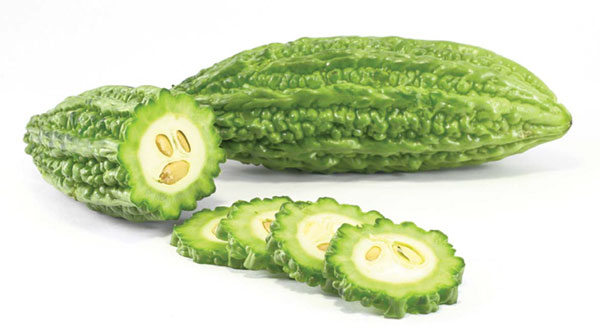Bitter favorite can be a sweet success

Editor's note: To understand China, sit down to eat. Food is the indestructible bond that holds the social fabric together. It is also one of the last strong bonds of community and culture.
The first vegetable I ever planted was a bitter melon. I had salvaged the large, creamy, ridged seed from my grandmother's kitchen waste and carefully nurtured it in a flower pot.
The vine grew quickly in the warm and humid climate and flowers soon appeared, followed by tiny fruits. It was a very satisfactory experiment.
Taste-wise, however, this is the one vegetable every Chinese child naturally hates, especially when it is forced upon the infant palate with the finger-wagging assurance "this is good for you".

I used to cower in fear whenever grandmother made bitter melon egg-drop soup.
Indeed, the bitter melon, or bitter gourd, is very hard to swallow.
Originally from South Asia, this peculiar vegetable found its way to the Middle Kingdom hundreds of years ago during the Ming Dynasty (1368-1644) through oceanic trade routes. It has since become an essential part of certain Chinese cuisines, especially in the southern maritime provinces.
It is a very pretty vine, with delicate palm-sized leaves and little yellow flowers that develop into a foot-long, green, ridged fruit. When it ripens, the fleshy golden melon bursts open and shows off creamy white seeds wrapped in bright red pulp.
Eaten while it is young and tender, the gourd is relished for its grassy bitterness in what becomes an almost masochistic appreciation.
No other fruit or vegetable resembles its unique taste, but it is this bitterness that has made it so popular. The Chinese believe it has cleansing properties, and its fruit, root and dried vine are all used in traditional medicine.
It is a vegetable that proves "bitter medicine is the best medicine" and is eaten to relieve hypertension, reduce blood sugar and lipids and clear toxins from the body for better skin, among other things.
Modern science has proved that the bitter gourd does indeed have many curative qualities.
There is another strange characteristic about this melon. It does not transfer its bitterness to the ingredients it is cooked with, and for this the Chinese call it the "gentleman's vegetable".
In recent years, as healthy food trends have spread to counter over-indulgence, even northerners are learning how to eat the bitter gourd.
One popular Beijing restaurant offering is chilled bitter melon salad.

Paper-thin strips of bitter melon are soaked in ice-cold, slightly-salted water. The salt helps draw the bitter juices, and the icy temperature crisps the melon strips. Drained and piled on a plate, the chilled strips are served with fruity dressings such as crushed blueberries, or a stronger drizzle of sweet-and- sour pickled plums.
Over in Taiwan, there is a variety of bitter melon that is pale green, almost white. While it is cooked just like the usual green gourd, Taiwan residents also like to drink it.
At the island's ubiquitous night markets, stalls offering fruit juices also sell bitter melon juice sweetened with honey. Again, it sells well because it is supposed to be a great detox drink to keep figures svelte and complexions fresh.
Elsewhere, along the same lines, young, dark-green and extremely bitter melons are sliced, air-dried and sold as herbal tea. This is targeted at people suffering high blood sugar levels.
But it is in the southern Chinese kitchen that the bitter melon truly comes into its own. It is cooked in soups, stir-fried, braised with meat and even pickled.
A bitter gourd needs to be properly treated before cooking. The pulp inside has to be thoroughly scraped out before it is sliced. Sprinkling salt over it will draw out bitterness and make it more palatable.
The Cantonese, like my grandmother, like throwing the melon into boiling water and then breaking an egg over the soup. Perhaps some chopped coriander will also go in.
This is a popular soup for hot days - but I hated it.
In fact, it took me quite awhile to actually learn to eat bitter melon, let alone like it. I think it has to do with taste buds. As we grow older, they become less sensitive to strong flavors.
Fortunately, that familiarization process is helped along by the alchemy of certain seasonings.
Oddly enough, bitter melon becomes delicious when paired with salted black beans, which in themselves have a certain savory bitterness. Pounded together with chili, ginger and garlic, the salted black beans give the bitter melon an almost licorice-like sweetness.
These are the background flavor notes to the delicious braised bitter melon with pork ribs, a Cantonese home-cooked classic.
Another popular dish you may encounter is stuffed bitter melon.
Cut crosswise into rings, the bitter melon is stuffed with a fish paste or minced meat mixture and deep-fried before being braised. The double-cooking eliminates the bitterness and the sweetness of the meat enhances the flavor of the melon.
Stuffed bitter melon rings are popular on their own, but they are also very much a part of the classic Hakka dish, niang doufu, or stuffed tofu. They become one of an assortment of vegetables filled with a fish and meat paste.
The pieces are served with noodles, either tossed in sweet and spicy sauces, or in a savory soup.
Bitter melon is an acquired taste but, once acquired, it poses a danger of addiction. And that's why I'm still growing bitter melons in my garden every year.
paulined@chinadaily.com.cn

Bitter melon and pork ribs
Ingredients:
1 large bitter melon
500g pork ribs
2 tbsp salted black beans, chopped
1 tsp minced ginger
1 tsp chopped red chili
1 tsp minced garlic
Salt to taste
Method:
Cut the bitter melon lengthwise and scrape it clean of pulp and seeds.
Cut into domino-sized pieces. Sprinkle with salt and set aside to draw out bitter juices. Rinse well after five minutes.
Cut pork ribs into bite-sized portions and blanch with hot water.
Mix together salted black beans, ginger, garlic and chili.
Pour some oil into a wok, and stir-fry the black bean mixture until fragrant. Add pork ribs and stir-fry over high heat. Add bitter melon pieces and fry till melon and ribs are evenly coated with the seasoning. Add enough water to just cover the mixture. Bring to a boil, then lower the heat, and cover to simmer for 30 minutes.
Adjust seasoning, then serve. The flavors actually improve overnight, if you can wait.

(China Daily European Weekly 10/28/2016 page19)
Today's Top News
- Xi calls for promoting volunteer spirit to serve national rejuvenation
- Xi chairs CPC meeting to review report on central discipline inspection
- Reunification will only make Taiwan better
- Outline of Xi's thought on strengthening military published
- Targeted action plan to unleash consumption momentum
- Separatist plans of Lai slammed






























